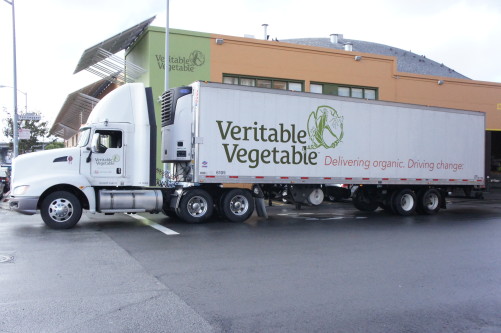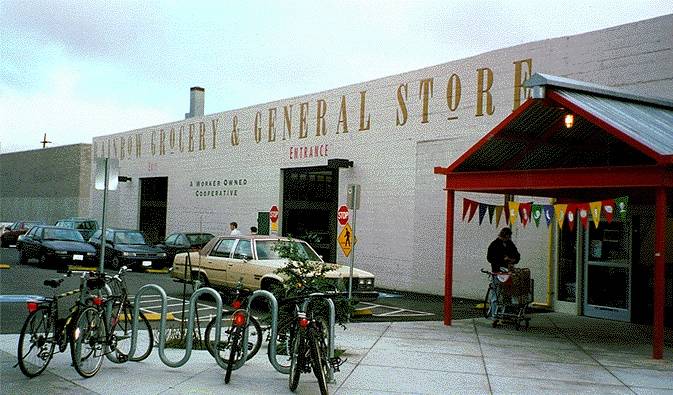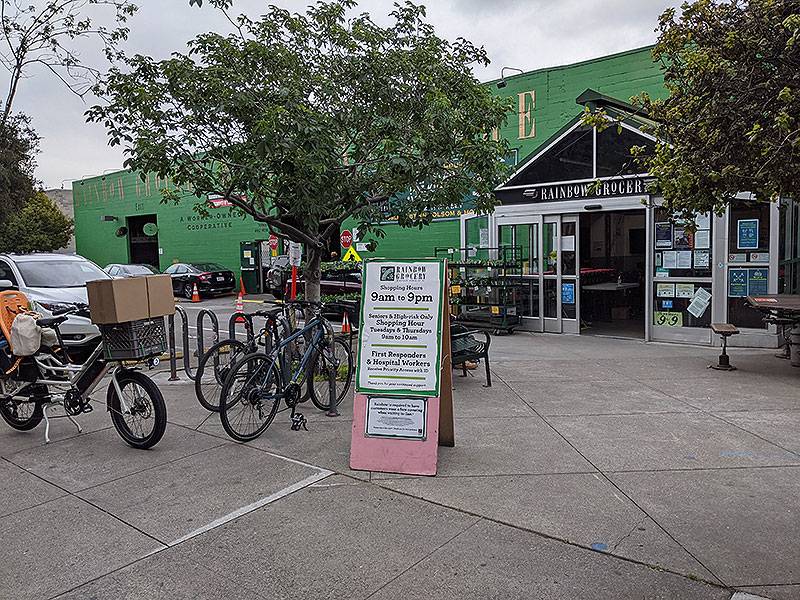Food for People, Not for Profit
Historical Essay
by John Curl, excerpted from a longer essay “Food for People, Not for Profit: The Attack on the Bay Area People’s Food System and the Minneapolis Co-op War: Crisis in the Food Revolution of the 1970s”
Veritable Vegetable truck at the warehouse on Cesar Chavez near 3rd Street.
Photo: courtesy goodfoodoneverytable.org
Veritable Vegetable is the oldest distributor of certified organic produce in the Nation today. Founded in 1974, it is woman-owned and socially responsible. They employ over eighty full-time workers, including over twenty drivers. Their 25,000 square foot warehouse at 1100 Cesar Chavez Street in San Francisco contains over 9,700 items, of which 97 percent are Certified Organic. Their fleet includes five bobtails and nine semi- tractor trailers. They buy from 340 produce vendors in California, New Mexico, Arizona and Colorado, and sell to approximately 300 stores, restaurants, and buying clubs. “We see our work as an opportunity to be both individually creative and cooperative, and we see ourselves as both a business and an instrument for social, economic, and environmental change.”(1) Veritable Vegetable started as part of the San Francisco People’s Food System, and retains many aspects of the mission, internal structure, and values of its mother organization.
Food for People, Not for Profit was the unifying principle, and byline, for the community-based food distribution network of which Veritable Vegetable was a part during the 1970s. Our motivation was control of the food supply for the common good, not profit seeking. It may be an outdated slogan, but today the words are still relevant to our business. Our goal is sustainability for our farmers, our customers and ourselves; to be sustainable we must be economically viable. Operating with the greater community in mind, offering fair prices when buying, selling and hauling, while providing good wages, benefits and equipment for ourselves, has enabled us to thrive.(2)
The new Rainbow Grocery on Division Street, 1997
Photo: Chris Carlsson
After twenty years, Rainbow's store on Division is more lived in...
Photo: Chris Carlsson, 2021
Another still-thriving enterprise that traces its roots to the People’s Food System is Rainbow Grocery Cooperative. Housed in a supermarket-sized warehouse at 1745 Folsom Street today, it is a cooperative corporation, with over 260 worker-members. Organized into fourteen autonomous departments, they coordinate day-to-day operations through an elected steering committee, and in larger issues and long-term planning, by an elected board of directors drawn from the workers:
Our goals include but are not limited to: Providing affordable vegetarian food products which have minimal negative impact ecologically and socially. Buying goods from local organic farmers, collectives, bakers, dairies and other local businesses whenever possible. Providing our customers with the best possible service. Providing Rainbow Grocery Cooperative’s workers with a livable wage. Creating a nonhierarchical workspace based upon respect, mutuality and cooperation. Offering low-cost health care products and resources. Supporting other collectives and worker-owned businesses. Supporting fair labor practices. Donating to local non-profit organizations and schools. Encouraging bicycling, mass transit, and alternative transportation. Composting all in-store green wastes; recycling, reducing and reusing resources whenever possible. Creating a diverse, non-discriminatory multilingual environment. We maintain an ongoing commitment to make Rainbow Grocery Cooperative an inclusive environment that is welcoming to everyone.(3)
Other Avenues Food Store Cooperative at 3930 Judah Street, a beloved neighborhood grocery with twenty-four worker-owners, started in 1974 and is the third still-successful alumna of the People’s Food System. Still preserving the legacy of their early years, they describe their mission today as “To provide our community with reasonably priced, high-quality products free of excessive packaging. To support organic agriculture and local wholesalers. To promote sustainable development . . . Workers manage the business democratically by making business decisions using the consensus model. We believe that it is as important to sustain a healthy democratic business as it is to nourish our bodies with healthy food.”(4)
Finally, Good Life Grocery, a very popular neighborhood business with two stores today, one on Potrero Hill and another in Bernal Heights, shares its origin with the others in the Food System. Although Good Life dropped its cooperative structure after leaving the network and went through a long period under the proprietorship of its two main founders, today it is an employee-owned business with those same founders still working in key management roles.(5)
The Good Life Grocery opened at 1457 18th Street in 1974. In 1985, the community came out in support of owners Lester Zeidman and Kayren Hudiburgh when they faced a 1000% rent increase. Forced to relocate, the store reopened in 1986 on 20th Street.
Photo: Lester Zeidman, from Potrero Hill Archives Project
Rainbow and Good Life both left the Food System when it started to become more centralized than they liked, and Other Avenues stopped attending meetings around that time. Veritable Vegetable, however, was caught in the thick of the conflicts that brought the System down, wound up flat on its back, then rose triumphantly from the ashes.
The San Francisco Bay Area People’s Food System (PFS) sprang from humble beginnings between 1973 and 1975, and involved thousands of people as workers, volunteers and customers. At its peak between 1975 and 1977, it consisted of about thirteen co-op/collective stores and about the same number of collectively run support enterprises. Some groups were short-lived, some were peripheral, and sometimes it wasn’t clear who was in and who wasn’t. The saga of PFS has attained a somewhat underground legendary status among a certain circle in the Bay Area. Perhaps that is because of the extraordinary circumstances surrounding its demise, which have never been totally aired. But the waters were so muddied back then, and have been so further obscured by time, that many details of the history may always remain shrouded.
However, one can still discern the drama played out against that clouded backdrop.
When a leader dies a premature, unnatural death under extraordinary circumstances, you always have to wonder what he or she might have done and if it might have changed the world. Organizations are a little different than people, but not that different. The Food System’s works had repercussions up and down the West Coast and across the county, and mention of its name still elicits strong emotions today. Because food is so essentially a political issue, many of the most volatile forces of the ‘70s interacted inside the ever-shifting walls of PFS during its short existence, and sometimes clashed. It suffered a mortal wound in 1977.
The Bay Area and the West Coast were not alone in trying to organize a counter- institutional food system in the 1970s. Groups across the country did the same. The movement in Minneapolis-St. Paul sprang from most of the same sources, and got hurled against a similar wall, in a series of clashes known as the Co-op War.
The food system movement of the ‘70s was a pioneer of today’s cooperative movement, particularly of social enterprises, solidarity enterprises, and food hubs. It was also a precursor of many of today’s food movements, involving organic and natural foods, food justice, food security, food sovereignty, local food, slow food, and community-supported agriculture.
Today’s Food Hub movement is in many ways a renewal of the ‘70s food system movement. Springing up almost spontaneously in many regions of the country today, food hubs bring together all the other movements in ways similar to the food systems of four decades ago. The current movement flows from almost all the same goals, spirit, and inspiration, is likewise fueled by the energy of a generation of young visionaries, is based on cooperation, and involves large numbers of ordinary and extraordinary people.
That is why it is important today to take a closer look at the history of the 1970s San Francisco People’s Food System. A deeper understanding can strengthen today’s movement, and hopefully help it avoid some of the hidden pitfalls that stood in the way of what the earlier movement was trying to build.
Notes
1. Veritable Vegetable, “About Us”.
2. Ibid., “Our Past”.
3. Rainbow Grocery Cooperative, “History”.
4. Other Avenues, “Our Mission and History”.
5. QDRO, GROCERY-PROFIT-SHARINGPLAN-38563.shtml “The Goodlife Grocery Profit Sharing Plan”.




